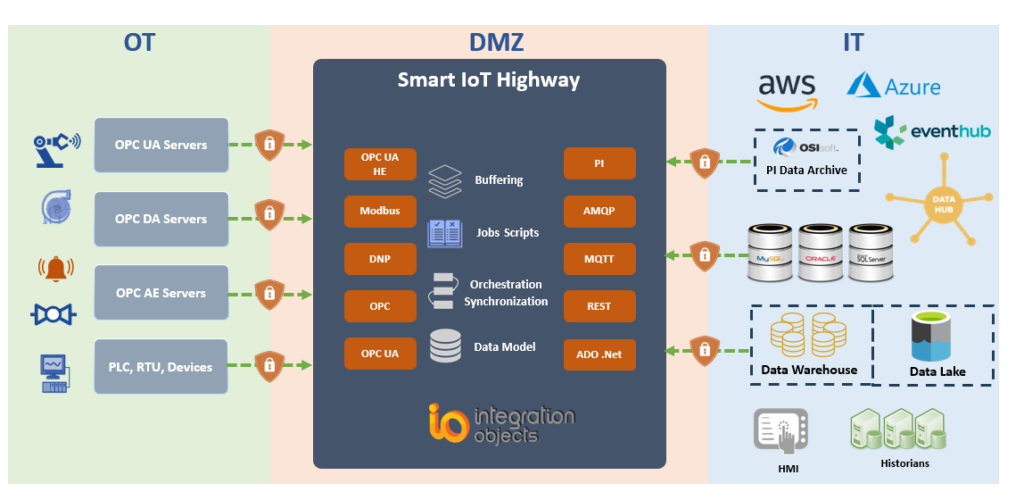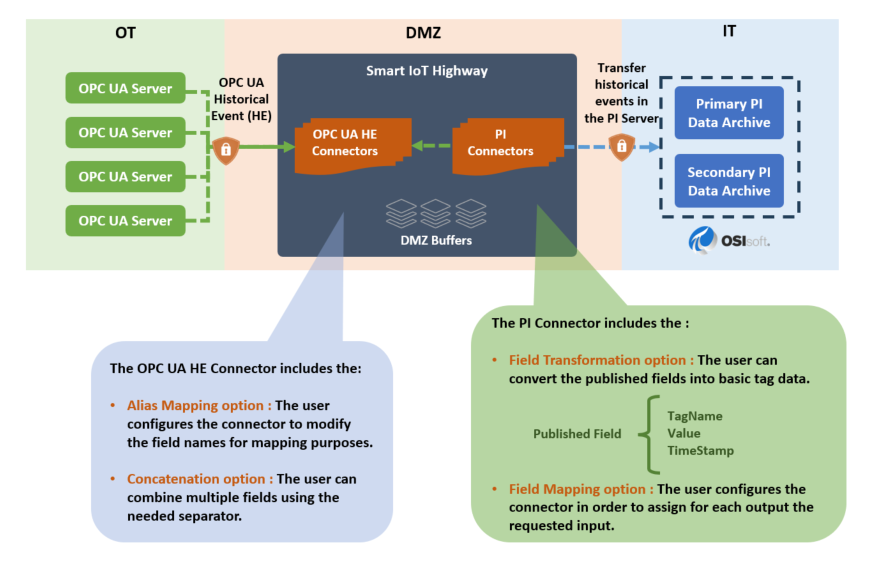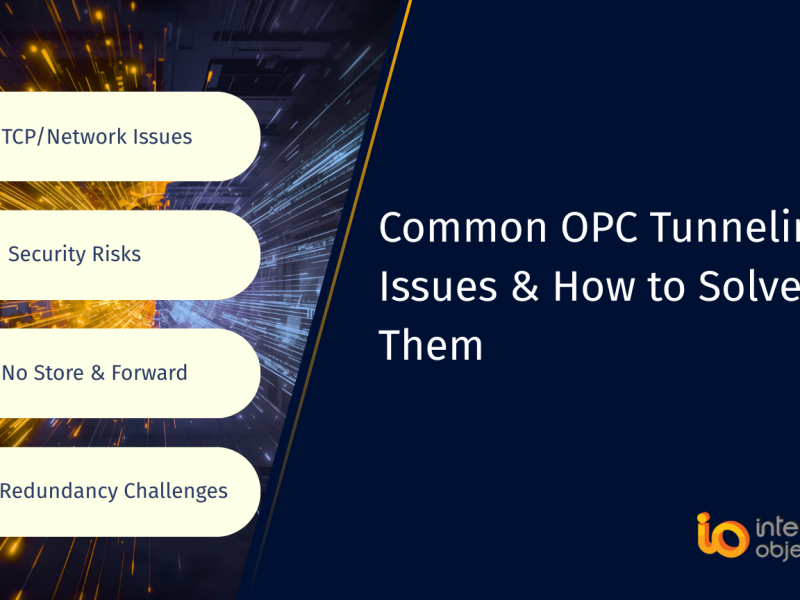In industrial settings, historical alarms and events data, especially from OPC UA servers, play a crucial role in maintaining operational efficiency, ensuring safety, and empowering operations informed decision-making. They provide a comprehensive record of past occurrences, allowing organizations to analyze trends, identify patterns, and predict potential issues before they escalate into major problems.
On one hand, by harnessing the insights gleaned from alarms and events, organizations can improve reliability, safety, and productivity while maintaining regulatory compliance and gaining a competitive edge in today’s dynamic marketplace.
On the other hand, the process of transferring alarms and events history poses several hurdles that organizations must overcome to unlock its full potential. But once data are stored in the cloud, users can identify repeated patterns, sequences of events, and root causes by performing smart analytics and AI on historical alarms and events.
Let’s delve into these challenges.
Challenges of transferring historical alarms and events from multiple sources to different historians
Navigating the complexities of transferring many attributes of alarms and events from multiple sources to different historian systems presents several challenges, each demanding meticulous attention and strategic resolution. Some of them are:
- Compatibility and interoperability issues: Integrating data from diverse sources into the needed destination can face compatibility and interoperability challenges due to differences in protocols, data formats (structured data, JSON, XML, or proprietary formats), and standards, vendor implementations, proprietary technologies, and legacy systems. These incompatibilities between systems may result in data loss, corruption, or misinterpretation, undermining the accuracy and reliability of analysis and decision-making processes.
- Data buffering: With high data volume and frequency, maintaining continuous data transmission without overwhelming the system can be daunting. Data buffering becomes crucial to handle fluctuations in communications, ensuring that no information is lost during network glitches.
- Cybersecurity risks: As data travels from different sources to multiple destinations, it traverses various networks, increasing the exposure to cybersecurity threats. Industrial systems are prime targets for cyberattacks, with potential consequences ranging from data breaches to operational disruptions and safety hazards.
- Scalability and performance: As industrial operations expand and generate increasing volumes of alarms and events, scalability and performance become critical considerations. Traditional data transfer methods may struggle to accommodate growing data loads, leading to scalability issues and performance bottlenecks.
Organizations must steadfastly adopt effective solutions to confront and overcome these obstacles, ensuring the accurate transfer of data to the designated historian system and map the data with the needed structure. These systems can collect, store, and analyze published data across historical system data types, either tag-based or non-tag-based.
Tag-based historian systems are widely used specifically in the process industry as they can reflect the process parameters in an organized manner (e.g., temperature, pressure, flow rate, or other key performance indicators). Some popular tag-based historians are OSIsoft PI System, Wonderware Historian (AVEVA Historian), and AspenTech IP21.
Due to their flexibility in structuring data, we have observed a growing trend of end-users opting for traditional relational databases like Microsoft SQL and Oracle, both on-premises and in the cloud, to archive alarms and events. This preference is increasing over the use of classical tag-based historians due to the lack of options on how to transform alarms and events and archive them into tag data tables. The use of Cloud data streaming services such as Azure Event Hub, Azure IoT Hub or Amazon Kinesis and MQTT Brokers is also increasing as they allow users to receive continuous data from sources such as OPC UA servers on the Cloud in real-time and then route them to a data lake.
Introducing SIOTH®: The Smart IoT Highway solution
SIOTH® emerges as a pioneering solution poised to tackle the challenges associated with transferring historical alarm and event data from multiple data sources such as OPC UA servers and Modbus servers to data historians and cloud historians’ system such as OSIsoft PI, Microsoft SQL, Data Lake, EventHub, NoSQL databases…
Discover SIOTH®
Once users build their alarms and events historians, they gain the capability to develop analytical and AI models. These models help identify patterns, sequence of events leading to process disturbances, potential equipment failures, and build predictive models to prevent abnormal situations. In this process, SIOTH® can play four key roles:
- Collect alarms and events from various sources such as OPC UA Servers and securely transfer them to a Cloud service, a data lake, a tag-based historian or to a SQL like database for model building and analytics.
- Structure the collected data in a uniform format to facilitate efficient analytics and model building.
- Filter out meaningless and false alarms and events, while adding complex, meaningful events using its rules engine.
- Deploy the models in real-time within the DMZ or on its Edge node using the rule engine
Below is an example of a SIOTH® architecture that demonstrates data transfer from multiple sources to various destinations through the DMZ, addressing multiple challenges and solutions.

Figure1: IT/OT Integration Architecture using SIOTH® for Streamlining Alarms & Events
How SIOTH® tackles the challenges of transferring historical alarms and events from multiple sources to different historians
SIOTH® employs advanced data buffering mechanisms to manage fluctuations in communications effectively and ensures smooth and uninterrupted data flow between OPC UA servers and historical data system.
Furthermore, SIOTH® warrants data security by implementing strong cybersecurity measures, including encryption protocols, access controls, and authentication mechanisms. SIOTH® complies with industrial cybersecurity standards such as ISA/IEC 62443.
Moreover, SIOTH® is designed to scale effortlessly to accommodate growing data volumes and increasing demands for performance. Its scalable architecture and optimized data transfer protocols enable efficient handling of large datasets, ensuring optimal performance and scalability to support evolving business needs.
SIOTH® also addressed interoperability challenges by supporting standardized communication protocols and implementing interoperability solutions, facilitating seamless data exchange and integration between data sources OPC UA servers and historian systems. As an example, refer to the dataflow diagram showing how SIOTH® facilitates the transfer of alarms and events from an OPC UA Server to Data Historians.
How SIOTH® Connects Historical Alarms from OPC UA Servers to Data Historians.
In this process, SIOTH® collects and integrates data from disparate sources into a unified format compatible with the target data historians.
SIOTH® first establishes connections to multiple OPC UA servers to retrieve historical events (HE). Then, SIOTH® begins the process of data transformation and mapping.
OPC UA servers store historical alarms and events in a structured format, with each event containing multiple attributes such as Severity, Time Reset, Acknowledgement Time, Event Type, Event Status, Event Code and other custom attributes.
Download SIOTH® Datasheet
As the operate on a tag-based structure, where each field is represented by a unique tag name, value and timestamp, SIOTH® bridges this gap by dynamically transforming the structure of the collected data from OPC UA servers into a format compatible with the Data Historians using field transformation options.
One of the key features of SIOTH® is its ability to manipulate data collected from multiple sources, including OPC UA servers, generating a unified output using configurable options such as alias mapping option and necessary separators. This way, alarms are properly organized and associated with their appropriate data point, simplifying data management and retrieval on the historian side
SIOTH® also handles the adjustment of event order to facilitate chronological analysis within the Data Historians system. For example, users can configure SIOTH® to adjust events with the same timestamp by adding a predefined interval to ensure that events are ordered sequentially for accurate analysis.

Figure 2: OPCUA to PI Architecture using SIOTH ® – Data Flow Example
In summary, ensuring seamless and reliable data delivery to users is essential. Using SIOTH® to integrate between OT OPC UA Servers and IT historian systems facilitates effective monitoring and trend analysis of data. Detecting alarms and events in real-time, while challenging, is significantly streamlined when all data from OPC UA servers is consolidated in one place with highlighted alarms and events. This enables chronological sequence of actions and events critical for identifying issues, troubleshooting, and maintaining oversight.



